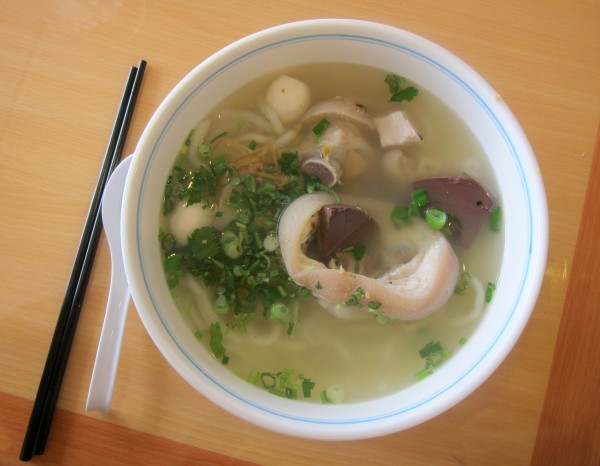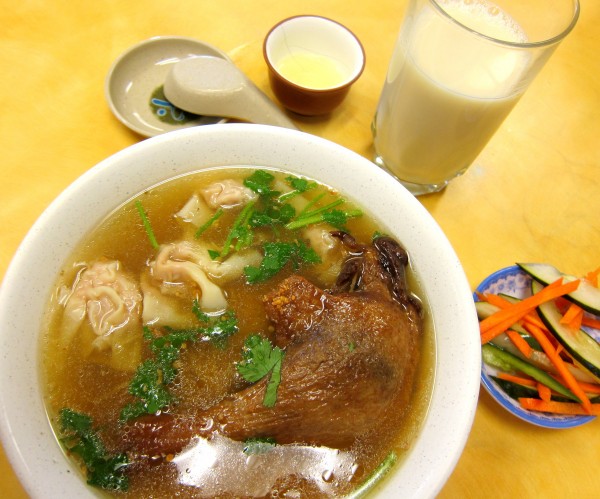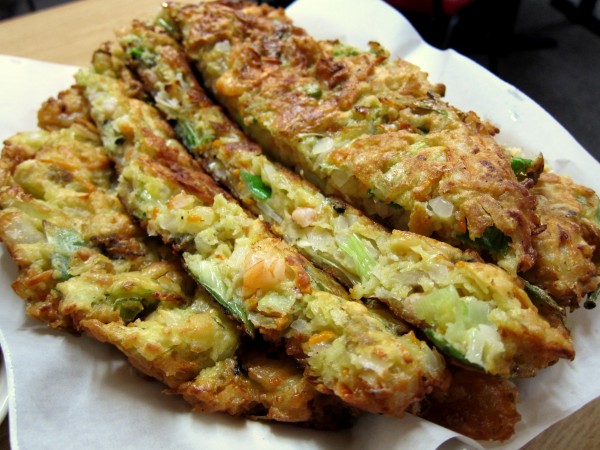 The third installment of the “Flavor Japan – Noodles” series: somen, i.e., Noodles Part 3. Somen is thin white wheat noodle, much thinner than udon and much lighter than soba (buckwheat noodle). Why have I not seen any somen in The States?!! It most closely resembles the Vietnamese bún in bún thịt nướng (grilled pork with rice vermicelli). Is that why I love it the most now, more than ramen, udon or soba? Maybe. This noodle is such a beauty. The day we had it was also a beauty. We were wandering around Fukagawa at 10:45 or so and no restaurant that we wanted to try was open. Then I heard drumming and chanting, so I dragged Mutsumi toward the sound and ended up in Naritasan Fukagawa Fudoudou. Two imageries of this big temple will stay forever in my head: 1. a modern hall whose white outer walls are covered with a Sanskrit mantra in black, and 2. the fire ceremony with powerful drums, beautiful garments of the monks, and exceedingly warm and mellow chanting. We came in the middle of the ceremony, and it went on […]
Continue reading Flavor Japan – Somen
 Ramen is all hip now and if I were that into ramen, I probably would try a ramen shop everyday until I exhaust all options in Tokyo (it will take only a few lifetimes). But honestly, there’s SO MUCH MORE about noodles in Japan that I’m glad I didn’t spend all my time with ramen. I don’t regret one bit that I had only ONE bowl of ramen in Tokyo the entire stay. When I think about the spaghetti with boiled anchovy (you can also have it raw) or somen and rice with clam(*), I’m filled with joy. (I really am!) Ziggy’s Pasta is an unassuming shop a stone’s throw away from Koutoku-in in Kamakura – the temple with the great copper statue of Buddha, where 60% of the tourists stick their hands out for a statue-carrying pose. When we visited in Kamakura, my life goal was too eat shoujin ryouri (精進料理) – traditional Buddhist vegetarian meal, but that goal was quickly quenched because everybody and their grandma were lining up outside every restaurant during lunch time, and no shoujin ryouri restaurant was opened […]
Continue reading Flavor Japan – Noodles Part 2
 Quite possibly the cheesiest name of a store I’ve ever seen: Bánh Canh Quê Anh & Quê Em – “bánh canh [from] your hometown and my hometown” (it doesn’t sound cheesy translated into English, but trust me, it’s like Twilight’s Edward Cullen in noodle soup form). Which is actually fitting, since banh canh is commoner’s grub, not a bourgeois lunch. You won’t find a classy madame dressing up just to go out for banh canh. The poor thing will never be elevated to the level of pho. I love it. I grew up eating it before I was born (literally). Backstory can be told in person, but despite eating so many bowls, I never knew that there was so many types of banh canh. Que Anh & Que Em offered 30 types (see menu at the bottom), 14 of which are no more traditional than the Spider Roll, but the other 16 are attached to geographical regions in Vietnam, and thus, in this case, more meritable. Banh canh is a thick, chewy, slippery rice noodle (with tapioca starch). It’s similar enough to udon in appearance and texture (as the shop aptly translates it […]
Continue reading Noodle soup: Banh canh Que Anh & Que Em
 The luxury of cold noodles on colder days. Everything was perfect, from the taste of wasabi in the noodle dipping sauce to the tail end of those shrimps. So perfect that I couldn’t properly focus my camera phone. Too bad Chef Koichi Ishii only makes the soba on Friday and Saturday from 11 am to 1 pm. Pictured: Ten zaru soba (soba with tempura shrimps and vegetables) – $18. More details on what’s in the picture are here.
 Like many small businesses in the so-called “Little Saigon”s throughout the states, Hai Ky Mi Gia is operated by Chinese immigrants. Originally, Hai Ky Mi Gia is a popular noodle soup joint in District 5, Saigon – the Chinatown of Saigon – before 1975, and it remains popular today. When Saigon fell, the Chinese immigrants in Vietnam left the country with the Vietnamese and became associated with Vietnamese political refugees in foreign lands such as America. These Chinese Vietnamese immigrants continue speaking both languages, opening businesses under the established names(*) in Saigon and catering to the homesick Chinese Vietnamese and Vietnamese alike. Whether this Hai Ky Mi Gia is in any way related to the Hai Ky Mi Gia in District 5 or other Hai Ky Mi Gia’s scattering across the US, its patronage doesn’t seem to care either way. To the Chinese Vietnamese and Vietnamese immigrants, it’s a name they’re familiar with, so they feel at home. To the rest of the patronage… well, I can’t speak from their point of view, but I guess the low price and the popularity raved by Yelp, InsideScoop SF, Continue reading Hai Ky Mi Gia – more noodle soups
 Kinoko harusame (~$8) – potato starch glass noodle soup with mushroom (shimeji, eryngii, enoki, hiratake (oyster mushroom), portobello mushroom and shiitake. Japanese glass noodle (harusame 春雨) is different from Vietnamese glass noodle: it’s made from potato starch (instead of mung bean starch or canna starch), it’s much thicker (like a spaghetti, whereas Vietnamese glass noodle is like a capellini), and it has a softer chew. With that vegan broth sweetened by mushroom, it was comforting. Continue reading One bite: Harusame soup at Cha-Ya
 It’s summer. Time for cold noodle. Refrigerated, ice-cold noodle. And all it takes is 10 minutes (that includes water-boiling time). Traditionally, the Koreans sweeten mul naeng myeon (물 냉면, “water cold noodle”) with sliced Asian pear and julienned cucumber. Asian pears are not yet in season (I don’t really know when its season is, but the tiny ones at Berkeley Bowl look too sad to slice), and when I want to cook my naeng myeon, like always, I never have what the recipe calls for, even if it’s just cucumber. So I did what everyone would. I ignored the recipe. Continue reading Ten-minute noodle and nectarine
 Unpredictability #1: “Are you opened today?” Before you set your GPS to Myung Dong in Houston, make sure you call and ask that question in the clearest, simplest way possible. Aaron tried different versions, most were a bit too elaborately polite with a perfect American accent, and only succeeded in confusing the poor old man. I tried it once and got the answer “Yes, open.” We hopped en route. (If you don’t call, there’s a slim chance that your schedule will coincide with the owner couple’s schedule, which depends on the lady’s health, and she’s the only chef. That slim chance didn’t happen for me the first time I set out for Myung Dong.) The limited English conversation is nothing uncommon at Korean and Vietnamese mom-and-pop diners, but I have to mention it because it’s one of those things that make me classify Myung Dong as more “authentic” than the other Korean restaurants in Houston. The second thing is that its name doesn’t contain “Seoul” or “Korean”, they go more local: Myungdong (명동) is a part of Seoul (in Vietnam, its equivalent would be a phường). The third thing is that […]
Continue reading The unpredictable Myung Dong
|
|
Blogs we read
|










